From Newton’s
early research on the composition of light and James Clerk Maxwell’s study
of electromagnetism, to John Logie Baird’s patenting of the concept of holey
fibers, the history of optics and photonics in the UK is littered with famous names.
Today, the strength of UK photonics lives on in five main areas:
defense photonics; plastic electronics; optical communications; medical technology
and life sciences; and optical components and systems.
With 96 distinct research groups currently involved in photonics
and more than 1500 photonics companies in operation, the field is thriving in the
UK. The majority of photonics companies are small- and medium-size enterprises (SMEs),
with 70 percent employing between one and nine employees, 22 percent employing between
10 and 49, and 7 percent employing from 50 to 249. Only 1 percent of the UK’s
photonics companies employ 205 or more workers. A recent study, carried out by the
UK’s Photonics & Plastic Electronics Knowledge Transfer Network (PPE KTN),
found that the UK photonics industry has a turnover of at least £5.9 billion
($8.8 billion) and employs more than 51,000 people.
Underpinning industrial activities is a solid academic base as
well as governmental support. So far, the UK government has played an important
role in strengthening certain areas of photonics, but most believe that this could
always be improved. In 2007, the UK government launched the Technology Strategy
Board (TSB) to promote, support and invest in technological areas that offer the
greatest scope for boosting UK growth and productivity.
A key area identified by the board is the global market for consumer
electronics and photonic products, which was valued at $291 billion in 2007. Market
growth is attributed to the increasing popularity of items such as flat panel displays,
digital imaging equipment, CD and DVD players, portable entertainment (of which
a large percentage is MP3 players) and portable navigation devices.
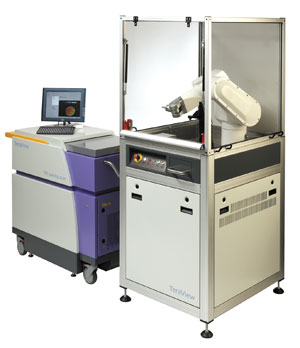
TeraView’s tablet imaging instrument for development and quality assurance of drugs. Courtesy of TeraView.
According to the TSB’s 2008-2011 strategy for electronics,
photonics and electrical systems, the UK has the world’s fifth largest market
for electronic goods and the seventh largest production base; in Europe, it ranks
as a close second to Germany. Electronics, photonics, and information and communication
technologies directly account for around 10 percent of the UK’s economy but
also bolster a broader base of activity.
To support growth in this sector, the TSB sponsors the PPE KTN,
an initiative that sets out to promote the photonics and plastic electronics sectors
of UK industry and academic research and to facilitate the transfer of technology
from academic research to industry.
UK sensing hits the headlines
Another area highlighted in the TSB strategy is the global sensors
market, estimated at $61.4 billion in 2010. The global instrumentation and control
market is estimated at £100 billion with the UK having annual sales of around
£12 billion ($17.9 billion); these instruments are an essential part of the
£165 billion ($246billion) of manufactured goods in the economy.
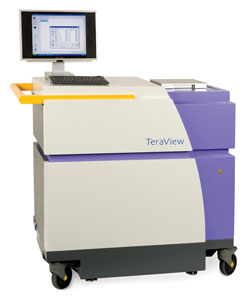
This image illustrates TeraView’s highly flexible pulsed terahertz engine. Additional
modules and fibers allow its use for a wide range of imaging and spectroscopy applications.
Courtesy of TeraView.
The UK has always had a strong record in developing new sensing
techniques. A good example of this is TeraView of Cambridge, which develops terahertz
sources and sensors with the support of its collaboration partners. One of TeraView’s
sensors recently hit the headlines when terahertz light was demonstrated for the
first time to detect different types of plastic explosives through clothing; included
was PETN, the explosive that the Detroit bomber successfully carried undetected
onto an aircraft.
As with many UK photonics companies, TeraView started life as
a spin-off from an academic center – in TeraView’s case, the Toshiba
Cambridge Research Laboratory in Cambridge. TeraView’s chief executive officer
believes that, although setting up in the UK is simple enough, maintaining momentum
can be tricky.
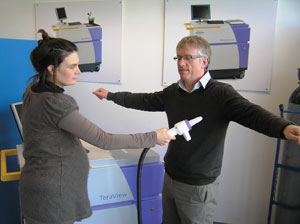
TeraView offers people screening capabilities using terahertz light.
Courtesy of TeraView.
“Setting up companies in the UK is relatively straightforward
in terms of administrative and legal issues,” said Dr. Don Arnone. “Raising
funds for new ventures, however, is getting steadily more difficult.”
The CEO of Michelson Diagnostics in Kent agrees. There are a lot
of photonics SMEs in the UK, which suggests that it is easy to start up, says Jon
Holmes. However, it is harder for these companies to reach profitability in the
UK than in the US, due to a smaller domestic market. This results in most UK startups
focusing on export markets, especially to the US, but this is expensive.
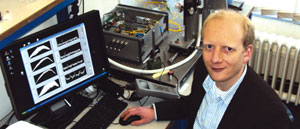
Application scientist Daniel Woods of Michelson Diagnostics is at work on the company’s ground-breaking multibeam optical coherence tomography technology. Courtesy of Michelson Diagnostics.
Arnone believes that it is up to the UK government to step in
and plug the funding shortfall. At the level of fundamental science, there are good
programs in place coupled with EU funding. There are opportunities for universities,
companies and other organizations, such as the TSB, the Engineering and Physical
Sciences Research Council and so on. But as for the transition of technology from
early-stage laboratory-based research to field-deployable systems, Arnone believes
that there is a gap in the UK government’s funding in addressing large markets.
“In the past, this gap was filled by venture capitalist
funding, but this is becoming progressively more difficult,” he said. “The
US government funds such activities through its Small Business Innovation Research
and related programs, but the UK lags behind. This has affected critical areas such
as homeland security and defense, where new technologies could play an important
public role.”
According to Holmes, however, photonics is well-recognized by
the UK government as a sector with strong potential to address key societal and
market needs, such as telecommunications, energy efficiency and health care in the
aging population. To date, Michelson Diagnostics has received several matched funding
grants to support R&D worth a total of £466,000, as well as advice and
support on accessing export markets. In addition, Michelson’s investors include
seed funds that are backed partly by the government.
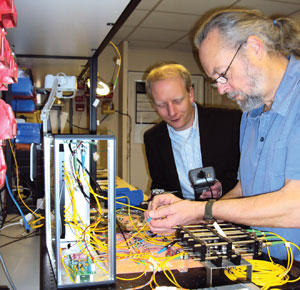
Members of the Michelson Diagnostics team are shown in the lab testing the optics for the VivoSight high-resolution
scanner. Courtesy of Michelson Diagnostics.
Investment from industry
Recognizing the importance of investment is not simply the job
of the UK government, however; those within the industry must also play their part.
The UK boasts a strong R&D base in laser materials processing (LMP). Although
Germany remains the world leader in the use of lasers in manufacturing, there is
strong technological know-how in the UK that could be pushed. What is missing, according
to Mike Green, executive secretary of the UK’s Association of Laser Users
(AILU), is a strong market pull from the manufacturing industry.
“German organizations seem to try harder to keep laser processes
within Germany (i.e., they use lasers to increase productivity and add value to
the product), whereas UK organizations are more willing to export the process to
Asia,” he explained. “In a recent assessment of LMP machines in the
UK undertaken by AILU, we concluded that the use of lasers in Germany per unit of
manufactured output is around five to 10 times that of the UK.”
Green cites the relatively low level of capital investment by
the UK manufacturing industry as another problem. “It is claimed that expected
payback times on investments are broadly one year in the UK, three years in Germany
and 10 years in Japan,” he said. “If true, this would certainly discriminate
against high capital cost purchases in the UK. To improve the situation requires
a change in attitude in the UK manufacturing industry, including a willingness to
increase its level of long-term investment.”
Academics versus industrialists
Marrying the pursuits of academia with those of industry is not
always easy in any country, but when the right balance is struck, a fruitful partnership
can emerge. Holmes believes that, although UK photonics companies work very actively
with the academic sector as well as with other firms, cooperation could be further
improved by making more funds available for small collaborative projects, which
could seed larger-scale collaborations.
Andrew Harvey, a professor of optics at Heriot Watt University
in Edinburgh and a director of the Industrial Doctorate Centre in Optics and Photonics
Technologies, believes that the UK photonics industry would benefit from a narrowing
in the gap between the agenda of academics and industrialists.
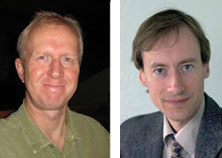
Professor Andrew Harvey, left, of Heriot Watt University in Edinburgh is a director of the Industrial
Doctorate Centre in Optics and Photonics Technologies. Courtesy of Heriot Watt University.
At right, CEO of Michelson Diagnostics, Jon Holmes, gives his views on the photonics
industry in the UK. Courtesy of Michelson Diagnostics.
“Generally, there is significant scope for improving mutual
understanding between academics and industry. There remain elements of academic
snobbery where practical application is not sufficiently valued and, equally, there
are elements within industry that are unaware of the rich potential for wealth creation
by partnering with universities,” Harvey said. “In reality, there is
a large area of overlap where universities and companies can work together for mutual
benefit – the key is to find the appropriate funding schemes.”
Recruiting photonics professionals in the UK
Although a number of universities offer optics and photonics courses
in the UK, it is not always easy to attract students into the industry. Harvey believes
that a misconception among students draws them into alternative industries.
“There is a perception that the manufacturing industry,
engineering and the sciences are in some way of lower status than the service industries,”
he said. “I believe that correcting this misunderstanding is the single biggest
obstacle to the UK’s prospects as a high-wage, high-technology society, but
that would be to reverse the deep-seated trend set in place since the end of the
industrial revolution.”
Perhaps one answer would be to adopt a more industrial approach
to learning, suggests Holmes. “We have been fortunate in finding some graduates
with the right skills, but it has not been as easy as I would like,” he said.
“I admire the French system, which places greater emphasis on placing students
in industry (fully funded) as part of their degree. This results in graduates who
require less training when they start in a company, as they already have exposure
to a variety of commercial environments.”